Menu
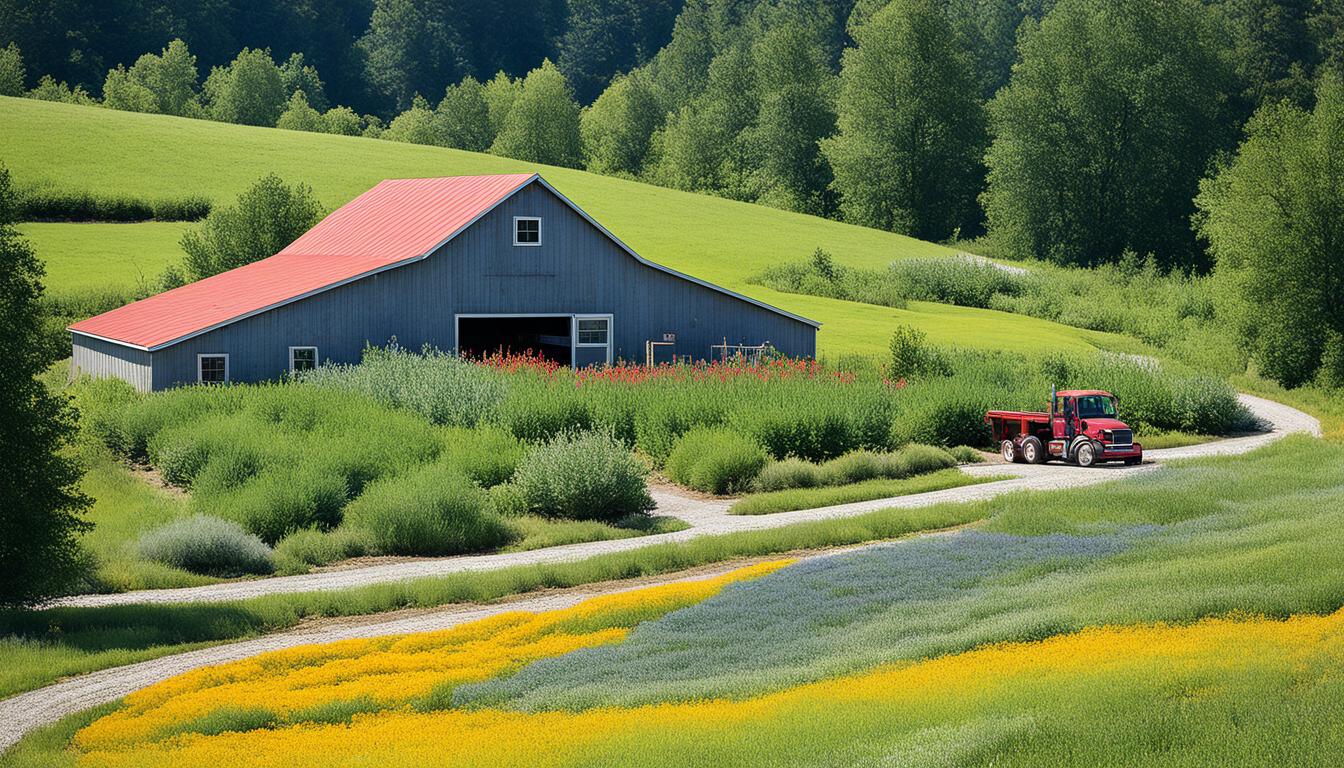
Standing on my family’s farm, I looked out at the land. It’s been ours for ages, providing food and life. I realised our farming ways could help or harm local wildlife.
About 70% of the US, except Alaska, is privately owned land. This land is often used for farming and ranching by many. If we farm in a way that helps wildlife, these areas can become homes for many.
Having good places for wildlife to live is crucial. The Conservation Reserve Program (CRP) is a great example. It protects areas near streams and offers safe places for animals. This helps our food and our natural spaces to thrive.
By caring for the land, we also get cleaner water, more plants and animals, and healthy soil. We must protect the earth while making it work for us. Farming can be about more than just what we grow for ourselves.
Sustainable wildlife habitat farming means farming in ways that don’t harm the environment. It is also good for the economy and treats people fairly. This method helps restore the living spaces of animals. It uses farming methods that are friendly to wildlife and helps the whole ecosystem stay healthy.
In the US, the Department of Agriculture’s Farm Service Agency (FSA) leads many helpful programs. These programs encourage farmers to protect wildlife habitats, keep water clean, prevent soil erosion, and save forests and wetlands. They also aim to help farmers recover from natural disasters.
The Conservation Reserve Program (CRP) pays farmers to not farm some areas. Instead, they grow plants that are good for the environment. The Conservation Reserve Enhancement Program (CREP) focuses on urgent environmental issues. It pays farmers for their role in this.
The Emergency Conservation Program (ECP) and Emergency Forest Restoration Program (EFRP) help repair damaged farmlands and forests after disasters. The Farmable Wetlands Program (FWP) supports the restoration of wetlands on farms. It offers money to encourage farmers.
The Grassland Reserve Program (GRP) works to keep grazing lands from turning into something else. It pays farmers to keep these lands just as they are. The Source Water Protection Program (SWPP) helps keep water clean for people living in the countryside.
Today, we try to farm in ways that reverse old mistakes. A long time ago, overgrazing and bad ranching hurt the land. Now, we see fewer cows on federal lands but more care for the land. This change is very important because so much of America’s lands are either public or private. Both types of land are valuable for wildlife and plants.
Farms and private lands offer important services like drinking water. They are home to most wetlands and many endangered animals. By farming in a way that helps these spaces, farmers do a huge part in nature conservation. They help keep the land rich and full of life.
Sustainable agriculture offers big pluses for wildlife. It concentrates on making more varied plant and animal life and on taking care of the land. Farmers do this by mixing tree growing with crop farming and by growing diverse crops. This way, many different creatures find good homes. Such methods help nature and farming work together well.
This way of farming also helps keep many kinds of plants and animals alive. It does this by using fewer man-made chemicals that can harm the environment. Rather than using these chemicals, farmers keep the soil healthy and let water stay clean. This not only helps crops grow better but also stops water animals live in from getting ruined.
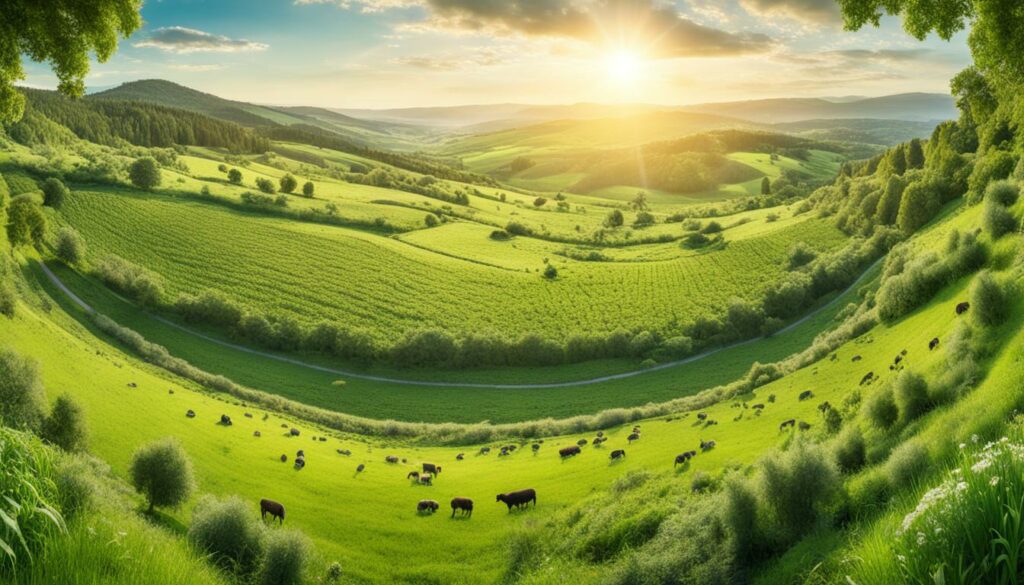
Studies support the benefits of farming the sustainable way. For example, some research done in the U.S. and the U.K. found that taking away wildlife to make food safer didn’t really help. But changing how farmland is looked after did. It led to more food being grown, better plant pollination, and soil that’s healthier, all without hurting clean water.
Farming sustainably focuses on saving wild living areas and not using too much land or harmful chemicals. This way, nature gets a chance to heal and grow back. It turns farming into a way to care for the Earth.
To sum up, sustainable farming does a lot of good for nature. It boosts the number and types of living things, makes landscapes healthier, and shows how people and the environment can support each other.
It’s key to use effective conservation practices in farming to support sustainable wildlife habitats. This includes saving grasslands and adding natural barriers. These actions help wildlife and make our water cleaner.
Keeping big areas of grassland is very important in farming right. This special work helps birds that love the grasslands by giving them safe places to live and grow. One helpful scheme is the Conservation Reserve Program (CRP). It’s got over 22 million acres saved. This program pays farmers to keep their most delicate lands away from farming. This keeps the important grasslands safe and well.
By making natural strips of land near streams and lakes, we help a lot. These green barriers stop the earth from washing away, keep the water pure, and give animals paths to move. These paths are critical for animals to travel and mix with other groups, making a stronger natural world. The Environmental Quality Incentives Program (EQIP) gives a hand by funding actions that better water and homes for animals.
Adding buffers also helps keep the water safe for people living in the countryside, thanks to the Source Water Protection Program (SWPP). This program puts aside $250 million to protect water, making sure it’s clean and enough for the folks there.
Brush management helps wildlife habitat farming by removing unwanted woody plants. This makes more food for animals and improves water quality. It also makes areas better for wildlife, like in Pennsylvania where many animals depend on dead trees for homes and food.

Invasive plants, like rose bushes and kudzu, can push out native plants. This reduces the kinds of plants that can grow. To fight this, farmers use safe ways to control these plants, sometimes with the help of fences or brush piles.
Animals might eat young plants, so fences are put up to keep them safe. This helps the land stay healthy for the animals that live there. Adding brush piles also gives small critters a safe place to hide.
In Texas, too many or the wrong kind of plants can be a big issue. This can make it harder for both livestock and wildlife to find good food. By burning some plants, using chemicals, and managing where animals graze, the land gets better for everyone.
| Brush Management Goals | Benefits |
|---|---|
| Increase Grazeable Acres | Enhances forage availability for livestock and wildlife |
| Improve Wildlife Habitat | Ensures diverse and supportive environments for various species |
| Increase Visibility | Facilitates better land management and species monitoring |
| Maintain Plant Diversity | Protects native plant species and controls invasive types |
Keeping a good balance on the land needs careful planning. People use methods like burning and controlling how animals eat to keep the area healthy. After the first work, regular checks help make sure the land stays in good shape.
Prescribed or rotational grazing is key to sustainable habitat farming. It involves moving livestock between pastures plus benefits the environment and economy. This approach also considers the needs of herds and local wildlife.
Rotational grazing improves soil health. It moves livestock between paddocks so the land has time to rest. This helps avoid soil compaction and boosts water flow and drain. These changes lower risks like erosion and contamination. So, farms and wildlife both win with this strategy.
Rotational grazing helps both livestock and wildlife. It creates diverse areas for different species’ needs. This doesn’t just support animals, it boosts farm income too. Farming gets better with more food for animals and less damage to the land. Also, it captures carbon and makes habitats safer for wildlife.
| Benefit | Description |
|---|---|
| Soil Quality | Prevents compaction, improves water infiltration and drainage. |
| Cost Savings | Utilises manure directly, reduces feed raising time. |
| Animal Health | Enhances forage quality and quantity. |
| Environmental Benefits | Carbon sequestration and improved wildlife habitat. |
Forest stand improvement boosts and keeps forests healthy. It uses methods like starting new forests, lessening fire risks, and making homes for wildlife. By growing forests with different ages of trees, they help keep the forest diverse and good for animals and wood production.
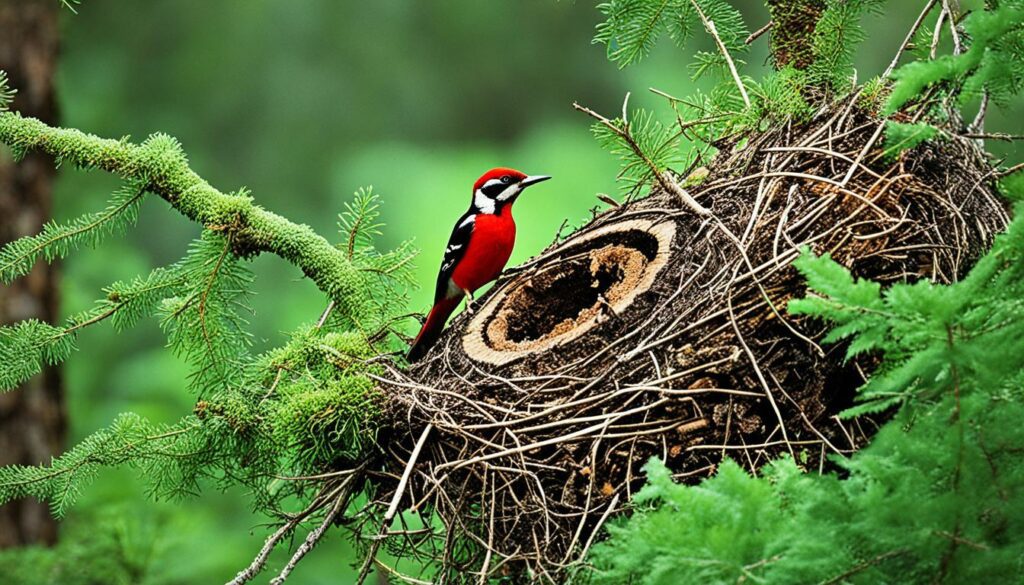
This method works on any land needing more and better trees. It involves changing what types of trees grow, how many there are, and their arrangement. Making sure there is a plan, keeping the best trees, and planting them right helps a lot.
A big goal is to make forests healthier. This is done by protecting them against pests and too much or too little water. Leaving certain trees and wood on the ground helps wildlife and protects them. It also changes how much water forests let out, which keeps the environment balanced.
It also tries to protect the ground and the plants already there. Certain rules, like those for Forest Trails and Woody Residue Treatment, help make sure forests are managed well without hurting the land.
Helping store carbon is another key part. Managing which types of trees grow and their numbers helps store more carbon. Tests like the Wildlife Habitat Evaluation Procedure and the Forestland Assessment Scorecard guide good forest care.
Improving forests can help the economy too. For instance, looking after special trees and clearing away vines can make a forest more valuable. It can also help animals. Changing the way we manage forests, like not cutting all trees at once, can also keep carbon in the forest longer.
For making wood sustainable, special care is needed. For example, letting trees grow freely helps make better wood. But cutting unwanted trees needs to be done carefully to not harm the environment.
Trimming young forests early can help them grow better. This, with other methods, makes the best trees even better. Then, taking out bad big trees can help the others grow well. This makes the forest both good for animals and for making wood.
Finally, making piles of cut trees is like building safe spots for animals. In the end, making forests better helps them stay useful and healthy for everyone.
Restoring wetlands is crucial for keeping ecosystems diverse and supporting wildlife. This process boosts the health of natural areas, especially where farming has damaged the land.
Bringing back stream habitats is vital in wetland restoration work. Nearly 2.9 million acres have been improved through special agreements. This effort helps many plants and animals, making the environment better for everyone. In Winnebago County, Iowa, about 1,000 acres of land were restored thanks to collaborative work.
Reviving streams also helps farmers. In Louisiana, Bonner Wiggers and family showed how to use land better for both farming and nature.
Keeping meadows healthy is key for wildlife. Over 40% of plant and animal types rely on wetlands, according to experts. People like Mark Magura and his wife have turned old farmland into a space where nature thrives.
Wetlands are also vital for local fishing industries. They are breeding grounds for many species and help with flood control. Their work in managing nutrients is important too, showing why we must protect these areas.
| Key Data | Impact |
|---|---|
| 2.9 million acres restored | Enhanced biodiversity through easements and contracts |
| 16,000 agreements | Support for wetland restoration on private and tribal lands |
| 225,000 acres | Protection of Louisiana Black Bear habitat |
| Constructed wetlands at Long’s Park | Improved water quality and increased habitats for aquatic wildlife |
| International coalition report | Highlighting the potential loss of over one million species |
By adding wildlife habitats to farms, we can really boost taking care of the Earth. Even little changes, like making small natural ‘hedgerows’ bordering fields, help a lot. These small spaces really make a big difference, especially for local bird life. They show how important it is to bring back natural areas.
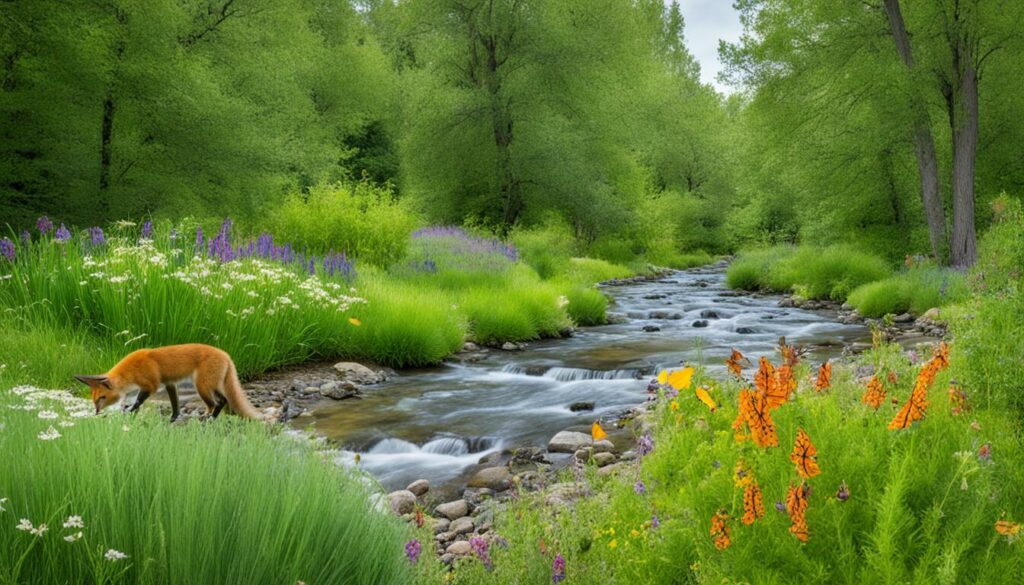
Studies from the Conservancy and the University of California, Berkeley, show that losing natural land for food safety isn’t wise. It was found that keeping these areas doesn’t cause more food poisoning germs. This busts a big myth.
Working with places like Cambridge, we’ve seen good results from different farm methods. They bring more crops, better pollination, and healthier soil, without messing up the water. Still, we’re not sure about all the effects of these new ways.
Scientists from the Conservancy and Cornell University looked at why farmers choose certain ways to farm. Money and the effort it takes are often big worries for them. This can keep great methods from spreading.
One great practice is using several fields for grazing animals. It saves water and makes soil and its health better. This helps the tiny life in the soil, too.
In the past, some thought having animals eat and move on fields was bad for nature. Now, we see farmers and their efforts to farm friendly. They’re learning to mix farming with helping wildlife through clever plant use. This makes homes for many animals.
Working together with bodies like the U.S. Fish and Wildlife Partners Program supports farmers in adding wildlife spaces. Since lots of land in the U.S. is in private hands, this support is vital. It helps turn farmland into useful places for nature.
Money is key for these ideas to work. The Farm Bill sets aside lots of money every year. Even though the funds were cut by Congress once, great programs like the Conservation Reserve Program (CRP) still protect many water areas. They make water cleaner and help fish.
Making places for wildlife on farms makes everything better for us. It brings back nature and helps farming be friendlier. This is good news for the environment and for making food.
Biodiversity enhancement is key to keeping ecosystems stable. Farmers who use wildlife habitat farming methods create spaces for many different species. This is important for making sure that our environments stay in balance. In the UK, most of the land is used for farming. This shows there is a great chance to improve biodiversity.
Studies show that using a lot of fertiliser and constant farming can harm nature. But, if farmers choose to use fewer chemicals, like in organic farming, it helps keep our environment rich and healthy.
It’s vital to keep some parts of farms natural to help different species thrive. Doing simple things, like leaving a space between hedges and crops, can be very helpful. This supports the environment and helps in tasks like pollination and controlling pests, which make farms more productive.
In fields, planting a mix of many plant types can make a big difference. Places that set aside some land for wildlife see better harvests of crops like wheat and beans. This means the more kinds of plants we have, the better our farms can be.
| Management Approach | Biodiversity Impact | Agricultural Yield |
|---|---|---|
| High-input Low-diversity | Low | Medium |
| Low-input High-diversity | High | High |
The table above shows that both farming methods can produce similar amounts of food. But the one that supports more wildlife is better for the long term. This way helps with food production and keeps our environment healthy.
In the end, creating more habitats for wildlife helps everyone. It makes our farms stronger and better able to face changes like those from climate change. This shows that choosing to farm in nature-friendly ways benefits us all.
Looking after nature is key to making sure farms help with food and protect natural areas. We use methods that balance the environment. This keeps farms going and supports all kinds of life.
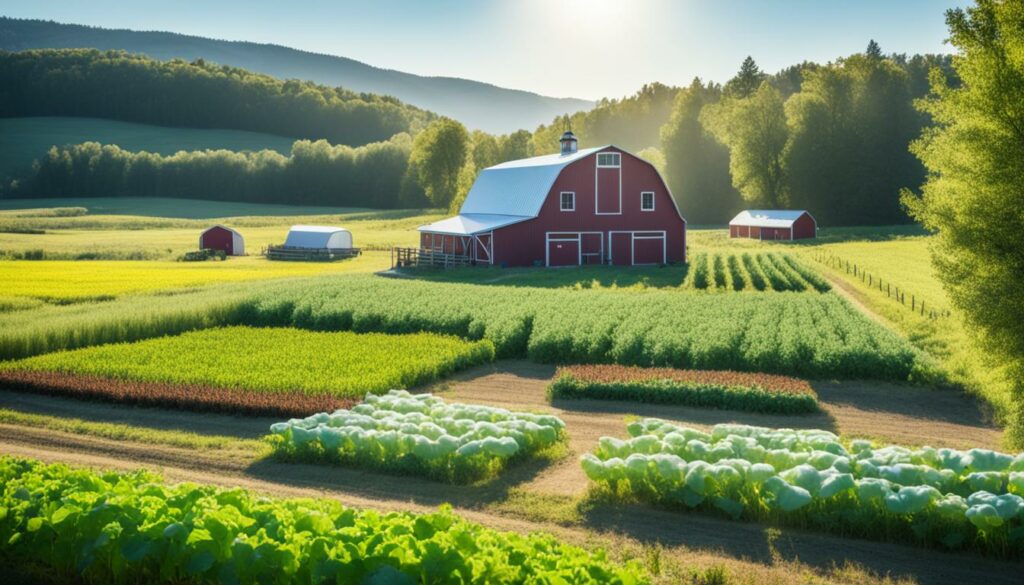
Caring for ecosystems is at the heart of what we do. We focus on keeping the soil, water, and a mix of plants and animals healthy. With smart farming methods, places like grasslands are doing much better. Since 1982, there’s been a big drop in soil being washed away and more bugs that help the soil and feed animals.
Reusing water in farming is also becoming more common. Every day, nearly 588 million gallons of water gets a new life in the U.S. This move helps keep farms going strong. It’s interesting that most farms in the U.S. are run by families, who are really into looking after the land.
Protecting wildlife needs everyone to pitch in. It’s cool that over 60% of folks in Pennsylvania love wild activities. This shows a real team spirit for taking care of nature. Also, local projects help grow a sense of togetherness in looking out for wild places.
Groups and local communities are making a big difference by working together. Connecting with organisations like Ducks Unlimited does a lot of good. They’ve helped farming areas become better homes for wildlife. Plus, thanks to programs like WHIP and EQIP, farmers get support to make their land friendly for plants and animals.
“Grasslands managed with strategic grazing produced 50% more invertebrates than those that did not.”
Wildlife habitat farming relies on good natural resource management. This includes using sustainable agricultural practices. These practices help save important ecological resources. Tools like the Web Soil Survey and Plant Hardiness Zones Map are crucial. They offer detailed soil information and help pick the right crops for the soil.
Good soil is key for successful wildlife habitat farming. It lowers costs, increases profits, and helps fight climate change. Healthy soil systems do a lot. They store carbon, let water soak in better, and support wildlife and pollinators. Soil Health Management Systems also help deal with bad weather, especially in the Northwest.
Many programs aim to support sustainable agricultural practices and natural resource conservation. The Conservation Reserve Program is one example. It turns easily eroded farmland into green areas, helping the soil and water. The Conservation Stewardship Program and the Environmental Quality Incentives Program give support and money. They encourage farming that’s good for the environment and keeps everything in balance.
The USDA Climate Hubs and related groups offer tools to fight climate change in farming. They even help cover some costs through soil and water districts. This support makes it easier for farmers to use eco-friendly practices.
“Integrating wildlife habitat into agricultural management can significantly improve the ecological balance, promoting biodiversity and ensuring long-term sustainability.”
Places like Iowa are leading in adding wildlife space to farms. They use smart farming near water and create windbreaks. This improves conditions for plants and helps animals thrive. Adding wetlands and buffer strips also helps protect the environment. It makes more homes for different wildlife.
| Program | Description | Benefits |
|---|---|---|
| Conservation Reserve Program | Converts erodible cropland into vegetative cover | Protects soil and water quality, enhances wildlife habitat |
| Conservation Stewardship Program | Offers technical and financial assistance | Improves land management, enhances conservation efforts |
| Environmental Quality Incentives Program | Provides assistance for implementing structural and management practices | Supports sustainable agricultural practices |
Wildlife-friendly farming supports the plan to restore habitats. It does this by saving native species and making routes for wildlife. These efforts help nature thrive on farms, making farming more sustainable.
It’s key to save native plants and animals for habitat repair. This keeps the environment in balance, which fights off pests and diseases. Even small natural ‘hedgerows’ by fields boost bird numbers. This shows why we need to keep and bring back local plants and animals.
Wildlife corridors are crucial for fixing habitats. They join up separate natural areas, letting animals move and mix genes. This helps wildlife stay healthy and improve the area around us. Buffers alongside water not only purify it but also help animals move more easily.
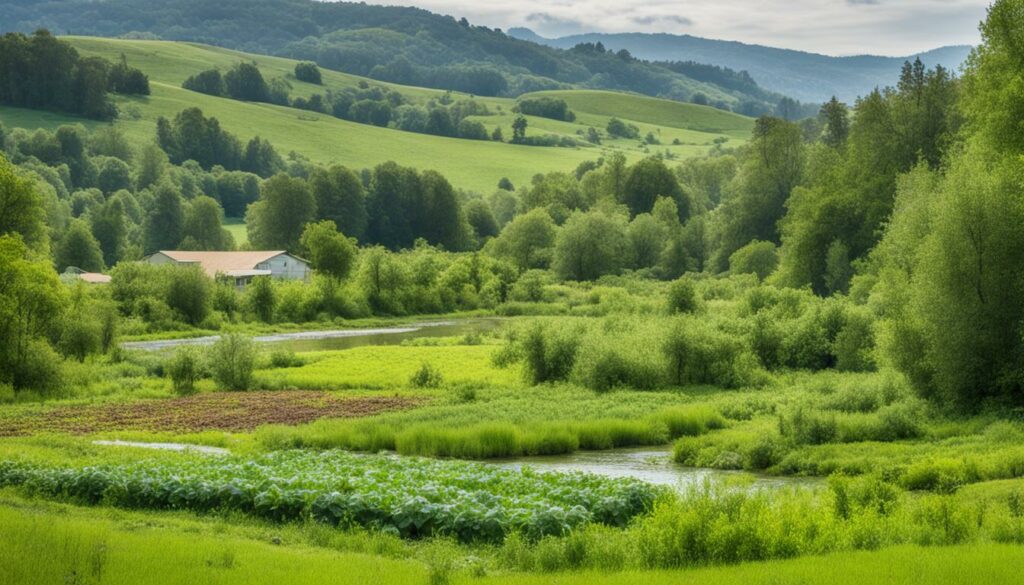
| Benefits of Natural Habitats | Impact |
|---|---|
| Diversity of Native Bird Species | Increased by small, linear natural “hedgerows” |
| Food Safety | Minimal impact from natural habitats |
| Ecosystem Services | Higher crop yields, improved soil quality, and pollination |
| Farmland Management | Provides water filtration, pest control, and pollination |
Sustainable agriculture supports our planet’s health in significant ways. It includes managing land for wildlife, which improves our soil, water, and air. This also helps to capture carbon and tackle climate change. When we care for soils, they can do many things. They ensure water flows well, help plants and animals to live, clean pollutants, and recycle nutrients.
Practising sustainable farming adds greatly to our economy. It contributed over $1 trillion to the U.S. economy in 2019. A large part of the U.S., about 45%, is used for farming. This shows the importance of managing our land well. Good land management supports the return of natural ecosystems. It also encourages farming that helps wildlife, benefitting us all socially and economically.
Around one-third of the world’s land is used to grow crops or to feed animals. Another 10–20% is for animals to graze. Sadly, human activity affects 80–90% of liveable lands. The demand for livestock products is sharply increasing, posing challenges. Growing this food sustainably is critical.
The agriculture sector is key to feeding us and keeps our environment healthy. Farms that support nature can be smart investments for the future. By farming in a wildlife-friendly way, we ensure our food production is sustainable. This approach protects various ecosystems and species. In turn, it helps more than 1.1 billion people who live in these areas.
| Service | Importance | Statistic |
|---|---|---|
| Soil Conservation | Prevents erosion and maintains fertility | Supports plant and animal life |
| Water Filtration | Maintains clean water supplies | California lost 91% of its wetlands |
| Pollination | Essential for crop production | Contributes to biodiversity |
| Carbon Sequestration | Mitigates climate change | Importance rising with carbon markets |
Agricultural schools, policy-makers, and farmers working together can bring big benefits. By choosing sustainable and wildlife-friendly farming methods, we protect our future. This step ensures our planet can thrive for many generations.
Looking at success stories in wildlife habitat farming shows how innovative ideas and hard work can make a big difference. These achievements help animals and the environment thrive.
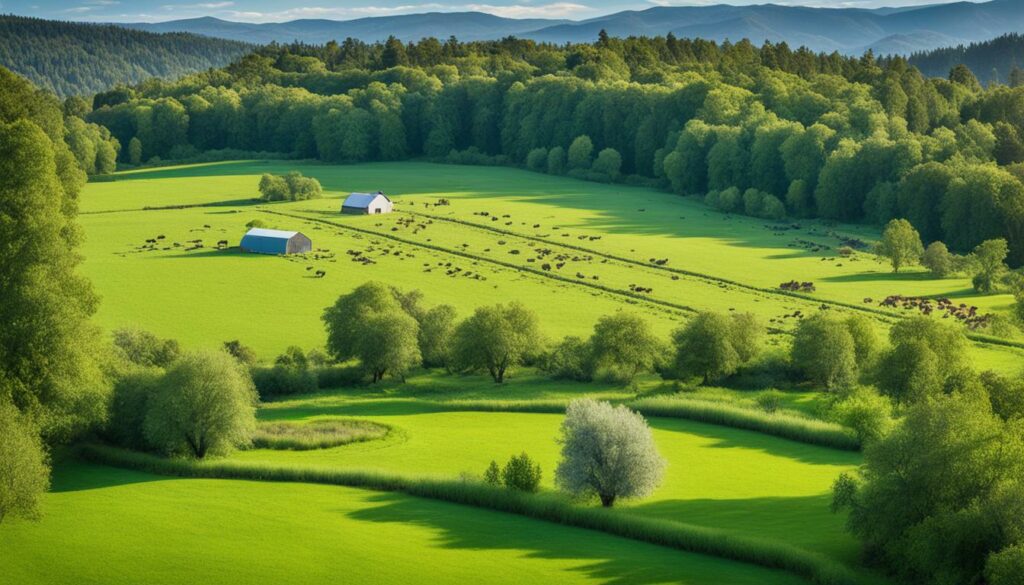
In the Conservation Reserve Program (CRP), many farmers have introduced new methods. For example, Mark and Amy Magura turned 200 acres of old farmland in Indiana into beautiful wetlands. Bill Cooper in Virginia also did a lot. With help from the Conservation Reserve Enhancement Program (CREP), he made eight acres of conservation areas. His farm also added over 13,000 feet of fencing and more than 1,100 trees.
Fourth-generation farmer Christopher Sumpter Jr. in South Carolina is another great example. He uses CRP to grow pollinator and tree areas, improving life for his Hereford and Black Angus cattle. Fifth-generation farmer Justin Knopf in Kansas has used USDA programs to expand his farm’s variety. His farm now grows wheat, alfalfa, corn, soybeans, and sorghum.
The tales of these farmers show real results. Wildlife habitat farming has not just helped their farms. It has also renewed prairie lands in the southern Great Plains. This proves that conservation efforts really work.
Bill Cooper’s work in Virginia has shown big improvements in soil and the area’s natural services. His use of fencing and pipelines demonstrates how investing in land benefits both the farm and the wild animals that live there.
These stories underline the power of wildlife habitat farming. They prove it can lead to a better environment, strong economies, and happy societies. Farmers can follow these models to help the planet. They can still do well while protecting nature.
| Farmer | Initiative | Key Outcomes |
|---|---|---|
| Mark and Amy Magura | Restored 200 acres into wetlands | Increased biodiversity and wetland health |
| Bill Cooper | Created conservation buffers and infrastructure | Enhanced soil health and ecosystem services |
| Christopher Sumpter Jr. | Planted areas for pollinators and trees | Improved farm’s wildlife habitat |
| Justin Knopf | Diversified crop operation | Increased operational resiliency |
Sustainable wildlife farming faces many sustainable agricultural challenges. Managing conservation with making money is key. Animals need various nutrients, including energy, protein, and vitamins. A lack of food can harm their health and the environment affects them too.
Water is also extremely important for livestock. Their needs vary with different factors. Managing water well is crucial. Wildlife habitat conservation obstacles make things even trickier. Destroying habitats risks wildlife lives, affecting their homes and food.
Destroying habitats makes it hard for wildlife to find essentials like shelter and water. This problem gets worse when habitats are broken up. Aquatic life and land animals face similar dangers from habitat loss.
Soil and water problems are big issues too. We must tackle these as they affect the animals. Also, we need to improve how we use energy and deal with pollution. These matters all link to how well wildlife farming can keep going.
Experts say we’ll need a lot more land for farming by 2050, about the size of India and Germany together. If we can’t do this without harm, 88% of land animal species might lose habitat. Also, with Africa’s growing population, finding solutions is urgent.
Yet, we can make positive changes. With the right actions, we could cut the needed land by 3.4 million km² by 2050. This could save nearly 7 million km² of land as well as many animal species from losing their homes.
| Challenges | Details |
|---|---|
| Livestock Nutrition | Demanding nutrient classes: energy, protein, minerals, vitamins, and water |
| Habitat Destruction | Risks to wild organisms, inadequate habitat conditions |
| Soil and Water Issues | Erosion, degradation, water quality and quantity |
| Energy and Air Quality | Impact from greenhouse gases, energy efficiency, and odours |
| Increasing Cropland | Projected need for an extra 3.4 million km² by 2050 |
| Population Growth | Anticipated increase over 1.1 billion in Africa |
The future of wildlife habitat farming brings big challenges and chances. By 2050, we might need an extra 3.4 million km2 of farmland. This is like making India and Germany one country in size. But, this could mean losing a lot of animal homes.
Most animals on land, like mammals and birds (88%), may lose part of their home. Places like Sub-Saharan Africa could see big losses. Also, creatures in Sub-Saharan Africa and Latin America face a high risk. Up to 93% of them might lose a lot of their space.
If nothing changes, about 1,280 kinds of animals might see big habitat losses by 2050. But, if we work hard to save nature, there’s hope. With strong conservation efforts, we could need less new farmland. This means saving an area bigger than India and Germany put together. We could keep the places animals live safe.
This shows how important it is to farm in ways that don’t harm nature. By focusing on agricultural biodiversity and better conservation, we can grow enough food for everyone. And, keep many animals safe too. Looking ahead, keeping these practices up to date is key. Our actions now will make a big difference for the earth of tomorrow. Sustainable farming is crucial for our farming and nature legacy.
It’s a method that uses both ecological practices and farmland. This method creates and keeps habitats that wildlife needs. It leads to a healthier environment and more productive land.
It helps keep a variety of plant and animal species. It makes sure their homes are safe and that they have what they need to survive. This helps the whole environment stay balanced and healthy.
These practices keep areas large and natural for wildlife to live and eat. They also help stop soil from being washed away and keep water clean. They make it easier for animals to move from place to place too.
Brush management means clearing out woody plants in fields. It gives more food for animals and makes water easier to find. It makes the areas better for wildlife to live in by offering more space and food.
Rotational grazing stops fields from being overeaten and worn out. It helps the ground and plants stay healthy. This means there’s more food and homes for wildlife to enjoy.
These techniques make forests more varied in plants and ages. It helps different animals find what they need. And it helps keep the forests healthy for the future.
Restoring wetlands helps all kinds of water-loving animals and plants. It makes the ecosystem rich and ready for many species. This work is key in saving clean water and diverse life.
It means using farming ways that keep the land, water, and life in good shape. This way we can live off the land but also keep it healthy for the future. It helps nature and farming work well together.
By making sure many different life forms exist in farmlands, we keep nature’s balance. This isn’t just good for wild animals; it also helps farms grow better and keeps the land strong.
It is very important. When people from a place work together to care for it, good things happen. This approach helps both nature and the community live well in the same place.
These strategies use the land and its resources in ways that last. They make sure we can keep farming and living without harming the environment. This is essential for future generations.
They focus on using local plants and animals to fix their habitats. They also help animals move around safely and find new homes. This is crucial for nature to bounce back and stay healthy.
Sustainable farming helps keep our earth clean by preventing soil erosion and cleaning water. It also makes sure food grows well and that our air is healthy. These are the basics we need for life.
Yes, there are many examples of how farms can help both nature and people. These farms show that taking care of the land the right way benefits everyone. They show we can have good food and a good place to live.
There are many challenges such as making sure farms are good for nature and still make money. We must also fight against climate change and break down walls between people. Solving these problems is key to making the earth a better place for all.